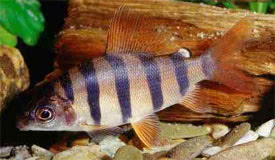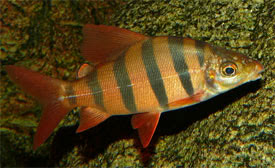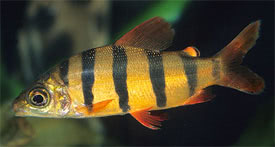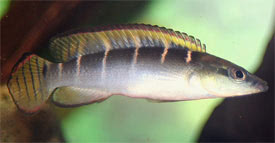Distichodus sexfasciatus - Six-banded Distichodus
 Magyarul / Hungarian
Magyarul / Hungarian

 Magyarul / Hungarian
Magyarul / Hungarian


- Scientific name: Distichodus sexfasciatus
- Common name: Six-banded Distichodus
- Group: Characins
- Habitat: Africa; Angola, Congo, Cameroon, Tanzania, Lake Tanganyika
- Size: 70 cm; usually 40 cm in aquaria
- Biotope: Inhabits in lakes and rivers, in the Congo basin
- Social behavior: A peaceful schooling fish, suitable for community tanks with similar sized fish. Older fish may become aggressive.
- Diet: Herbivorous; plants, stewed lettuce, corn, spinach, vegetable flakes, but also eats insect larvae and worms.
- Breeding: Not successfully bred in an aquarium.
- Tank: Minimum 540 litres
- Population: 2-3 fishes for 1200 litres
- Decoration: Prefers a longer aquarium with good swimming space. Since the fish is a jumper, the tank should be well covered. Furnish the tank with rocks and driftwood branches. Sand or gravel can be used as substrate. Java Fern or Anubias may not be eaten if sufficent food is offered. They require some hiding places.
- Temperature: 22-26 °C
- pH: 6-7.5
- Hardness: 10-20 NK°
- Lifespan: 10 years
Description: The young fishes are attractive in color, but adults become yellow-grey. The body is orange to reddish in color, and is marked by six distinct black vertical bands. The fins are bright red. Distichodus sexfasciatus has a sharp, bony beak instead of teeth, designed for scraping algae and plants from wood and rock. Their beak can also cause tremendous damage to other fish. As they mature, the brightness of its color may fade. While juvenile specimens will shoal together peacefully, they may become aggressive towards one another as they grow. A large tank would be needed in order to keep a group of adults. Distichodus spend most of the time in the lower regions of the tank, or in dimmer areas.
Hasonló vízparamétereket igénylő fajok


























